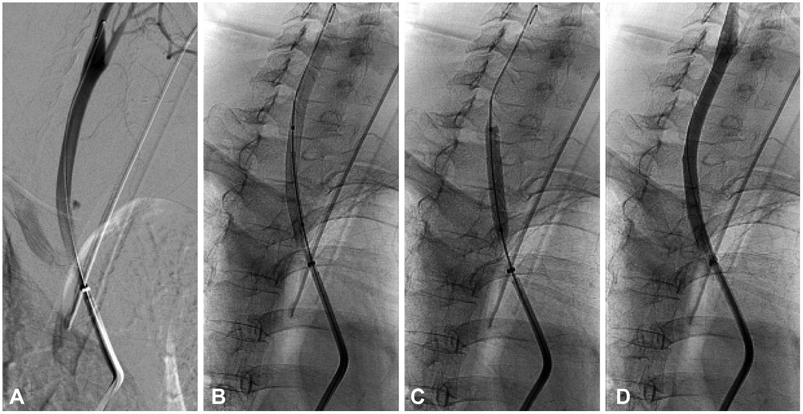Korean Circ J.
2011 Jul;41(7):405-408. 10.4070/kcj.2011.41.7.405.
Procedure-Induced Acute Common Carotid Artery Perforation Presenting With Airway Obstruction and Successful Treatment by Endovascular Stent Graft
- Affiliations
-
- 1Department of Cardiology, University of Ulsan College of Medicine, Asan Medical Center, Seoul, Korea. sjpark@amc.seoul.kr
- KMID: 2225106
- DOI: http://doi.org/10.4070/kcj.2011.41.7.405
Abstract
- A 63-year-old female was admitted to our hospital for catheter ablation during atrial fibrillation. After catheter ablation, the patient was transferred to the cardiac care unit and mechanically ventilated due to dyspnea and hypotension. Imaging showed active bleeding from the right common carotid artery (CCA) with extensive hematoma into the mediastinum. She was successfully treated with a stent graft at the CCA. Further bleeding or neurologic sequel did not occur after treatment.
MeSH Terms
Figure
Reference
-
1. Weaver FA, Yellin AE, Wagner WH, Brooks SH, Weaver AA, Milford MA. The role of arterial reconstruction in penetrating carotid in-juries. Arch Surg. 1988. 123:1106–1111.2. DuBose J, Recinos G, Teixeira PG, Inaba K, Demetriades D. Endovascular stenting for the treatment of traumatic internal carotid injuries: expanding experience. J Trauma. 2008. 65:1561–1566.3. Chaloupka JC, Roth TC, Putman CM, et al. Recurrent carotid blowout syndrome: diagnostic and therapeutic challenges in a newly recognized subgroup of patients. AJNR Am J Neuroradiol. 1999. 20:1069–1077.4. Kadkhodayan Y, Jeck DT, Moran CJ, Derdeyn CP, Cross DT 3rd. Angioplasty and stenting in carotid dissection with or without associated pseudoaneurysm. AJNR Am J Neuroradiol. 2005. 26:2328–2335.5. Sorial E, Valentino J, Given CA, Endean ED, Minion DJ. The emergency use of endografts in the carotid circulation to control hemorrhage in potentially contaminated fields. J Vasc Surg. 2007. 46:792–798.6. Kaskarelis I, Patronis M, Argiriou M, Zisis C. Images in vascular medicine: stent placement after iatrogenic carotid artery rupture. Vasc Med. 2008. 13:177–178.7. Alhaddad IA. Carotid artery surgery vs. stent: a cardiovascular perspective. Catheter Cardiovasc Interv. 2004. 63:377–384.8. Martin RF, Eldrup-Jorgensen J, Clark DE, Bredenberg CE. Blunt trauma to the carotid arteries. J Vasc Surg. 1991. 14:789–793. discussion 793-5.9. Demetriades D, Asensio JA, Velmahos G, Thal E. Complex problems in penetrating neck trauma. Surg Clin North Am. 1996. 76:661–683.10. Maran AG, Amin M, Wilson JA. Radical neck dissection: a 19-year experience. J Laryngol Otol. 1989. 103:760–764.11. Ciric I, Ragin A, Baumgartner C, Pierce D. Complications of transsphenoidal surgery: results of a national survey, review of the literature, and personal experience. Neurosurgery. 1997. 40:225–236. discussion 236-7.12. Asensio JA, Valenziano CP, Falcone RE, Grosh JD. Management of penetrating neck injuries: the controversy surrounding zone II injuries. Surg Clin North Am. 1991. 71:267–296.13. Fakhry SM, Jaques PF, Proctor HJ. Cervical vessel injury after blunt trauma. J Vasc Surg. 1988. 8:501–508.14. Raymond J, Hardy J, Czepko R, Roy D. Arterial injuries in transsphenoidal surgery for pituitary adenoma; the role of angiography and endovascular treatment. AJNR Am J Neuroradiol. 1997. 18:655–665.15. Prêtre R, Kürsteiner K, Reverdin A, Faidutti B. Blunt carotid artery injury: devastating consequences of undetected pseudoaneurysm. J Trauma. 1995. 39:1012–1014.16. Fabian TC, Patton JH Jr, Croce MA, Minard G, Kudsk KA, Pritchard FE. Blunt carotid injury: importance of early diagnosis and anticoagulant therapy. Ann Surg. 1996. 223:513–522. discussion 522-5.17. Pozzati E, Giuliani G, Poppi M, Faenza A. Blunt traumatic carotid dissection with delayed symptoms. Stroke. 1989. 20:412–416.18. Kocer N, Kizilkilic O, Albayram S, Adaletli I, Kantarci F, Islak C. Treatment of iatrogenic internal carotid artery laceration and carotid cavernous fistula with endovascular stent-graft placement. AJNR Am J Neuroradiol. 2002. 23:442–446.19. Maras D, Lioupis C, Magoufis G, Tsamopoulos N, Moulakakis K, Andrikopoulos V. Covered stent-graft treatment of traumatic internal carotid artery pseudoaneurysms: a review. Cardiovasc Intervent Radiol. 2006. 29:958–968.20. Dieter RS, Ikram S, Satler LF, Babrowicz JC, Reddy B, Laird JR. Perforation complicating carotid artery stenting: the use of a covered stent. Catheter Cardiovasc Interv. 2006. 67:972–975.
- Full Text Links
- Actions
-
Cited
- CITED
-
- Close
- Share
- Similar articles
-
- Treatment of an Acute Mycotic Aneurysm of the Common Carotid Artery with a Covered Stent-Graft
- Stent Graft Repair of Penetrated Injury of the Common Carotid Artery
- Iatrogenic Subclavian Artery Perforation Rescued by Operator-Modified Graft Stent
- Stent-Graft Repair of Common Carotid Pseudoaneurysms in Behcet's Syndrome
- Self-Expandable Stenting over a Stent Graft for the Exclusion of a Carotid Stump: Troubleshooting for Device Incompatibility




